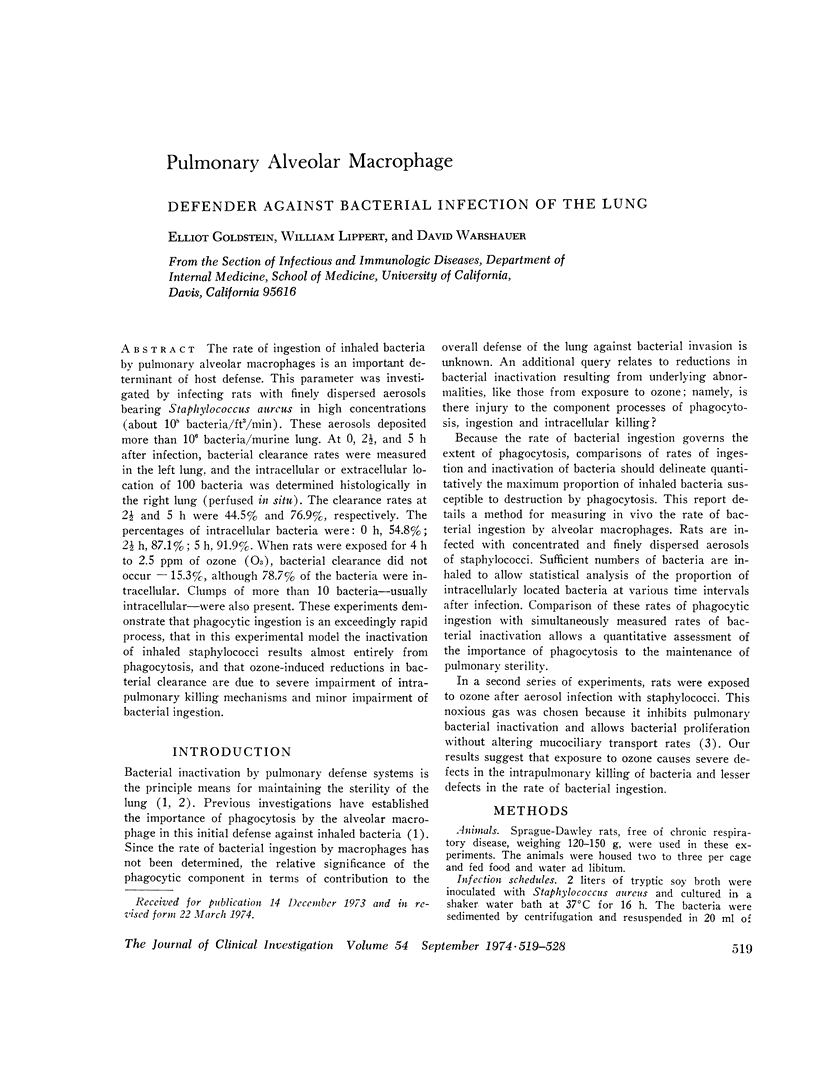Abstract
The rate of ingestion of inhaled bacteria by pulmonary alveolar macrophages is an important determinant of host defense. This parameter was investigated by infecting rats with finely dispersed aerosols bearing Staphylococcus aureus in high concentrations (about 10s bacteria/ft3/min). These aerosols deposited more than 106 bacteria/murine lung. At 0, 2½, and 5 h after infection, bacterial clearance rates were measured in the left lung, and the intracellular or extracellular location of 100 bacteria was determined histologically in the right lung (perfused in situ). The clearance rates at 2½ and 5 h were 44.5% and 76.9%, respectively. The percentages of intracellular bacteria were: 0 h, 54.8%; 2½ h, 87.1%: 5 h, 91.9%. When rats were exposed for 4 h to 2.5 ppm of ozone (O3), bacterial clearance did not occur — 15.3%, although 78.7% of the bacteria were intracellular. Clumps of more than 10 bacteria—usually intracellular—were also present. These experiments demonstrate that phagocytic ingestion is an exceedingly rapid process, that in this experimental model the inactivation of inhaled staphylococci results almost entirely from phagocytosis, and that ozone-induced reductions in bacterial clearance are due to severe impairment of intrapulmonary killing mechanisms and minor impairment of bacterial ingestion.
Full text
PDF









Images in this article
Selected References
These references are in PubMed. This may not be the complete list of references from this article.
- ANDERSEN A. A. New sampler for the collection, sizing, and enumeration of viable airborne particles. J Bacteriol. 1958 Nov;76(5):471–484. doi: 10.1128/jb.76.5.471-484.1958. [DOI] [PMC free article] [PubMed] [Google Scholar]
- Brain J. D., Frank N. R. Recovery of free cells from rat lungs by repeated washings. J Appl Physiol. 1968 Jul;25(1):63–69. doi: 10.1152/jappl.1968.25.1.63. [DOI] [PubMed] [Google Scholar]
- Brain J. D. Free cells in the lungs. Some aspects of their role, quantitation, and regulation. Arch Intern Med. 1970 Sep;126(3):477–487. doi: 10.1001/archinte.126.3.477. [DOI] [PubMed] [Google Scholar]
- GILL F. A., COLE R. M. THE FATE OF A BACTERIAL ANTIGEN (STREPTOCOCCAL M PROTEIN) AFTER PHAGOCYTOSIS BY MACROPHAGES. J Immunol. 1965 Jun;94:898–915. [PubMed] [Google Scholar]
- GREEN G. M., KASS E. H. FACTORS INFLUENCING THE CLEARANCE OF BACTERIA BY THE LUNG. J Clin Invest. 1964 Apr;43:769–776. doi: 10.1172/JCI104961. [DOI] [PMC free article] [PubMed] [Google Scholar]
- GREEN G. M., KASS E. H. THE ROLE OF THE ALVEOLAR MACROPHAGE IN THE CLEARANCE OF BACTERIA FROM THE LUNG. J Exp Med. 1964 Jan 1;119:167–176. doi: 10.1084/jem.119.1.167. [DOI] [PMC free article] [PubMed] [Google Scholar]
- Goldstein E., Green G. M., Seamans C. The effect of acidosis on pulmonary bactericidal function. J Lab Clin Med. 1970 Jun;75(6):912–923. [PubMed] [Google Scholar]
- Goldstein E., Tyler W. S., Hoeprich P. D., Eagle C. Adverse influence of ozone on pulmonary bactericidal activity of murine lung. Nature. 1971 Jan 22;229(5282):262–263. doi: 10.1038/229262a0. [DOI] [PubMed] [Google Scholar]
- Green G. M., Carolin D. The depressant effect of cigarette smoke on the in vitro antibacterial activity of alveolar macrophages. N Engl J Med. 1967 Feb 23;276(8):421–427. doi: 10.1056/NEJM196702232760801. [DOI] [PubMed] [Google Scholar]
- Green G. M., Goldstein E. A method for quantitating intrapulmonary bacterial inactivation in individual animals. J Lab Clin Med. 1966 Oct;68(4):669–677. [PubMed] [Google Scholar]
- Green G. M. Pulmonary clearance of infectious agents. Annu Rev Med. 1968;19:315–336. doi: 10.1146/annurev.me.19.020168.001531. [DOI] [PubMed] [Google Scholar]
- Jakab G. J., Green G. M. Regional defense mechanisms of the guinea pig lung. Am Rev Respir Dis. 1973 May;107(5):776–783. doi: 10.1164/arrd.1973.107.5.776. [DOI] [PubMed] [Google Scholar]
- Jakab G. J., Green G. M. The effect of Sendai virus infection on bactericidal and transport mechanisms of the murine lung. J Clin Invest. 1972 Aug;51(8):1989–1998. doi: 10.1172/JCI107005. [DOI] [PMC free article] [PubMed] [Google Scholar]
- Kass E. H., Green G. M., Goldstein E. Mechanisms of antibacterial action in the respiratory system. Bacteriol Rev. 1966 Sep;30(3):488–497. doi: 10.1128/br.30.3.488-497.1966. [DOI] [PMC free article] [PubMed] [Google Scholar]
- LAURENZI G. A., BERMAN L., FIRST M., KASS E. H. A QUANTITATIVE STUDY OF THE DEPOSITION AND CLEARANCE OF BACTERIA IN THE MURINE LUNG. J Clin Invest. 1964 Apr;43:759–768. doi: 10.1172/JCI104960. [DOI] [PMC free article] [PubMed] [Google Scholar]
- Levy P. S., Green G. M. A stochastic model of the bactericidal activity of the lung. J Theor Biol. 1968 Oct;21(1):103–112. doi: 10.1016/0022-5193(68)90063-5. [DOI] [PubMed] [Google Scholar]
- Snyderman R., Altman L. C., Hausman M. S., Mergenhagen S. E. Human mononuclear leukocyte chemotaxis: a quantitative assay for humoral and cellular chemotactic factors. J Immunol. 1972 Mar;108(3):857–860. [PubMed] [Google Scholar]
- Ward P. A. Chemotoxis of mononuclear cells. J Exp Med. 1968 Nov 1;128(5):1201–1221. doi: 10.1084/jem.128.5.1201. [DOI] [PMC free article] [PubMed] [Google Scholar]






